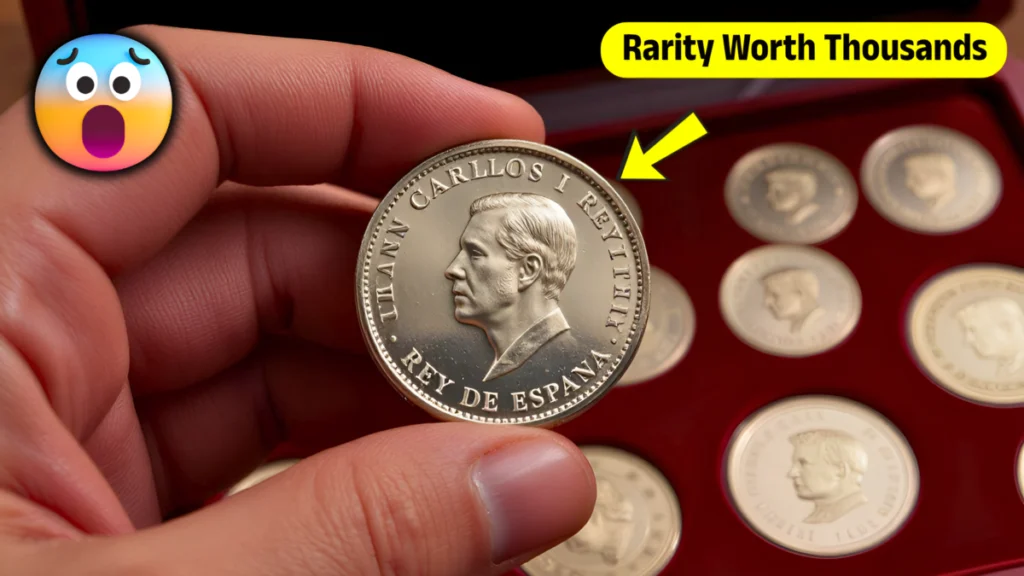For most people, a coin jar is nothing more than a humble collection of loose change a mixture of pennies, nickels, and dimes that accumulates over time. It’s an unassuming part of many households, filled up by the everyday coins that are no longer needed in our daily lives. But for one fortunate individual, that very coin jar turned into a goldmine, holding a rare find worth thousands of dollars.
The Unlikely Origins of a Coin Jar
Why do we keep coin jars? Perhaps it’s the simple convenience of stashing loose change instead of carrying it around. Over time, the change accumulates in jars, bowls, or old containers often forgotten until we finally decide to cash it in. For one person, this casual practice led to an extraordinary discovery when they decided to go through their old jar and see just what was inside. What they found was an unexpected surprise an item that would make any coin collector’s heart race: a rare coin with a value that would be worth thousands.

What Makes a Coin Valuable?
Not all coins hold equal value. While most coins are standard currency used in everyday transactions, others are much more than that. Their worth is determined by factors like rarity, history, and even errors during production. Below are some key elements that contribute to a coin’s value:
- Age: The older a coin, especially from a time when it was no longer in circulation, the more valuable it may become due to its limited availability.
- Minting Errors: Mistakes during the coin’s production process, such as double-stamps or misalignments, can turn an ordinary coin into a rare collectible.
- Metal Composition: Some coins are made from valuable metals like gold, silver, or copper, boosting their market worth.
- Limited Editions: Coins produced in limited quantities or for commemorative purposes often carry a higher price tag.
The Hidden Gem: A Rare Coin Discovery
This particular story began when the owner of the coin jar made a surprising find: an early 20th-century silver coin that had been misprinted, featuring a double-stamped date. This kind of error is incredibly rare and, in the world of numismatics (coin collecting), it immediately caught the attention of experts. After verifying the authenticity of the coin, appraisers estimated its value at more than $5,000 far more than anyone could have anticipated from a simple jar of change.
Coin Collecting: A Growing Passion
This discovery is a prime example of how one person’s casual collection can turn into a lifelong passion. Stories like this spark renewed interest in numismatics the study and collection of coins. Many enthusiasts find excitement in searching through their own coin jars, drawers, or even inherited collections, hoping for a similar stroke of luck.
Coin collecting is not just a financial investment; it’s a window into history. Each coin tells a story of the time and place from which it originated. The history of currency is rich, offering a fascinating glimpse into the economic and artistic influences of different eras. For collectors, it’s about more than money; it’s about owning a piece of the past.
How to Identify Valuable Coins in Your Collection
If you’ve got a coin jar of your own, it might be worth taking a closer look. Who knows what hidden treasures could be lurking in the bottom? Here’s a quick guide to help you spot potentially valuable coins:
- Examine Each Coin: Check the markings, dates, and inscriptions. A closer inspection can reveal hidden details that could be crucial to the coin’s value.
- Look for Minting Errors: Sometimes, production flaws like misprints, misalignments, or other mistakes can make a coin far more valuable than a standard piece of currency.
- Check the Composition: Certain coins, especially older ones, may be made of metals like silver or gold, which are worth more than the face value.
- Consult Experts: If you think you might have found something special, don’t hesitate to reach out to a professional appraiser or consult online numismatic communities.
A Lesson in Curiosity
What began as a simple habit of storing loose change in a jar has turned into a discovery that most people can only dream of. This tale reminds us that hidden treasures can be found in the most ordinary of places it just takes a discerning eye and a little curiosity.
So, the next time you find yourself with a coin jar filled to the brim, don’t just toss it in for cash. Take a moment to sift through the contents. You might be sitting on a rare coin worth thousands of dollars, just waiting to be discovered.
FAQs
How do I identify a rare coin in my collection?
Look for unique markings, unusual dates, or minting errors like double stamps or misprints, which can indicate rarity.
What factors determine the value of a coin?
A coin’s value is influenced by factors such as age, rarity, minting errors, metal composition, and whether it was produced in limited quantities.
Can minting errors make a coin more valuable?
Yes, minting errors, such as double stamps or misalignments, can make a coin much more valuable to collectors.
How do I know if my coin is made of precious metal like silver or gold?
Check the coin’s markings or consult with an expert to identify its metal composition; older coins often have inscriptions indicating their material.
Should I consult an expert if I think I’ve found a rare coin?
Absolutely! If you suspect you have a valuable coin, consulting a professional appraiser or numismatic expert is a great way to confirm its authenticity and value.
